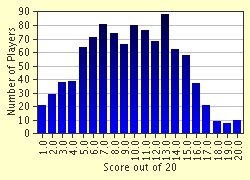
Animal Missing Letters Trivia Quiz
Oops, I did it again! I have written down 20 animals on a piece of paper and once again, the words smudged, leaving a word of 4 consecutive letters. Using additional letter(s) complete the word.You must look at the 'letter count' hint.
A multiple-choice quiz
by Inquizition.
Estimated time: 10 mins.
